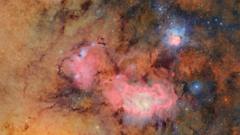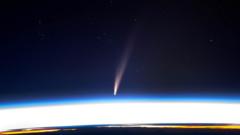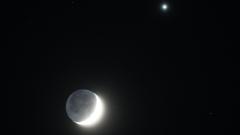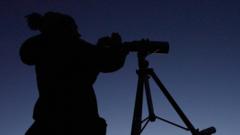Just as Halloween approaches, astronomers report on two remarkable black holes, one known for its destructive prowess, while the other is part of a unique three-body system, challenging existing astrophysical theories.
Cosmic Chills: Two Black Holes Stirring the Starry Skies

Cosmic Chills: Two Black Holes Stirring the Starry Skies
Mysterious black holes create cosmic chaos, captivating astronomers and sparking new discoveries.
As the Halloween season unfolds, astronomers are keeping a close eye on two black holes that are causing quite a stir in the cosmos. One black hole is gaining notoriety as a "serial killer," having recently been observed preparing to consume its second star in just five years. The other, dubbed part of a "black-hole triple," presents a unique astrophysical scenario that has not been seen before, as it includes a black hole in a system traditionally thought to consist only of regular stars.
Black holes, as described by Einstein’s theory of general relativity over a century ago, are regions of immense gravitational pull, remnants from stars that have collapsed under their own weight. Within our Milky Way galaxy alone, millions of these cosmic entities can be found, while each galaxy is believed to host a supermassive black hole at its heart, often having masses ranging from millions to billions of times that of our sun.
The infamous killer black hole was first detected five years ago when astronomers reported a significant flare from a galaxy located 215 million light-years away. This flare marked the arrival of a star that had ventured too close to its galaxy's supermassive black hole, resulting in what is known as a "tidal disruption event," specifically designated AT1910qix. Over several months, gravitational forces dismantled the star, stretching its remains into a vast ring that encircled the black hole. In a striking turn of events, while half of this stellar debris succumbed to the black hole, the rest began to disperse in an expanding disc.
Currently, this residual debris has drifted out far enough from the black hole that it now interacts with another star, which orbits the black hole every 48 hours. Each time the star traverses this remnant disc, it triggers violent X-ray emissions and other forms of radiation. An international team of astronomers, led by Matt Nicholl from Queen’s University in Belfast, has taken on the task of observing this phenomenon using several high-end space telescopes, including the Chandra X-ray Observatory and the Hubble Space Telescope. Their findings were published recently in the journal Nature.
In a parallel discovery, astronomers have identified a fascinating situation in which a third body—a black hole—is present alongside another black hole in a gravitational dance, truly expanding the horizons of what is considered possible within astrophysical frameworks. As these discoveries unfold, they not only deepen our understanding of black holes but also raise further questions about the complexities of cosmic interactions.












